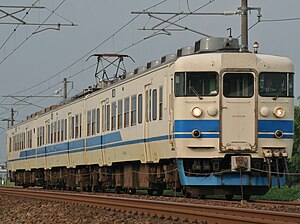| 413 series | |
|---|---|
 JR West set B9 in August 2010 | |
| Constructed | 1985–1989 |
| Entered service | March 1986 |
| Number built | 31 vehicles (11 sets) |
| Number in service | 31 vehicles (11 sets) |
| Formation | 3 cars per trainset |
| Fleet numbers | B01–B11 |
| Operators | JNR (1986–1987) JR-West (1987–2021) Ainokaze Toyama Railway (2015–) Echigo Tokimeki Railway (2021–) |
| Depots | Kanazawa |
| Lines served | Hokuriku Main Line Ainokaze Toyama Railway Line |
| Specifications | |
| Car body construction | Steel |
| Car length | 20,000 mm (65 ft 7 in) |
| Width | 2,950 mm (9 ft 8 in) |
| Doors | 2 pairs per side |
| Maximum speed | 110 km/h (70 mph) (service) 130 km/h (80 mph) (design) |
| Traction system | Resistor Control |
| Traction motors | MT54 (120kW) |
| Power output | 120kW |
| Transmission | Gear ratio: 19:80 |
| Electric system(s) | 1,500 V DC, 20 kV AC, 60 Hz overhead catenary |
| Current collector(s) | Pantograph |
| Track gauge | 1,067 mm (3 ft 6 in) |
The 413 series (413系, 413-kei) is a Japanese dual-voltage (1,500 V DC and 20 kV AC 60 Hz) electric multiple unit (EMU) train type first introduced by Japanese National Railways (JNR) in March 1986, and later operated on local services on the Hokuriku Main Line by the West Japan Railway Company (JR-West) from 1987[1] and also by the third-sector railway operating company Ainokaze Toyama Railway from March 2015. The units were built by re-using the underframes, bogies and electrical equipment from former 471 series and 473 series express-type EMUs with new suburban type bodies based on the design of the 417 series EMUs introduced in 1978.[1]
- ^ a b JR全車輌ハンドブック2009 [JR Rolling Stock Handbook 2009]. Japan: Neko Publishing. 2009. p. 297. ISBN 978-4-7770-0836-0.